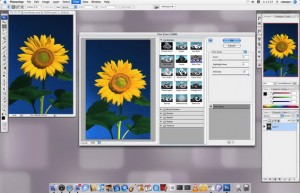Two Files Are Better Than One
 There are times when we should be working (or experimenting) on a copy of an image – it’s a shame to trash a good image then try to recreate it.
There are times when we should be working (or experimenting) on a copy of an image – it’s a shame to trash a good image then try to recreate it.
You could always do a Save As and choose As a Copy, but here’s a better way: Go to the bottom of the History palette and click on the Create New Snapshot icon (the one that looks like a camera). Click on the new snapshot near the top of the History palette to make it the active History state.
Finally, go to the bottom of the History palette and click on the Create New Document from Current State icon. There you go, a copy of the image, just dying for you to trash it.
Reaching the Free Transform Handles
If you want to use free transform on a layer, but image extends beyond the edges of your document window (and this happens frequently if your collaging different photos together), you wonÕt be able to reach the free transform handles to scale your image down to size. HereÕs the hidden keyboard shortcut that lets you reach each and every handle, no matter how far the image extends outside your current canvas area. Just press Command-T to bring up free transform, then press Command-0, and your window will zoom exactly the right size to enable you to reach all the handles. Cool!
Transforming and Copying at the Same Time
Generally, when you apply a transformation to an object (scaling, rotating, distorting, perspective), you apply that transformation to the object itself. However, hereÕs a cool tip if you want to apply a transformation (using Free Transform) on a duplicate of your object, rather than on the original: Press Option-Command-T, then use the Free Transform tool as you usually would. YouÕll notice that as you begin to transform, the original object remains untouched, and copy is transformed instead.
Finding the Photographic Brush Tips
Adobe hid ‘em, but they’re there – a few photographic brush tips, and it’s worth giving them a try just to see what they can do. To find these photographic brush tips, go to the brushes palette, and from the palettes pop-down menu, load the set named Special Effect Brushes. Try the Large Roses brush (just click it a couple of times in your image), or the Ducks brush. Then click-and-drag the first brush (the flowers) and watch what happens. Try the third brush in the list, and paint a few strokes. Pretty neat stuff.
How to Duplicate a Color Stop
Here’s the scenario: You’re making a custom gradient and you need to duplicate one or more of the color stops. No problem. Once you’ve created one gradient Color Stop, you can make copies by Option-dragging it key. Also, as long as you keep the option key down while you drag, you can jump right over existing stops. It’s a color stop love fest. Can you feel it?
Zooming All Your Tiled Images at Once
If you’ve chosen to tile your open your windows (in the Windows menu, under Arrange, choose Tile), in Photoshop CS you get some hidden functionality. If you want all the tile images displayed at the same level of magnification, just hold the shift key, grab the zoom tool, zoom in on one of the images, and all the other tiled images will jump to that same magnification. This is great when you’re trying to compare a number of similar images for detail.


No comments
Be the first one to leave a comment.